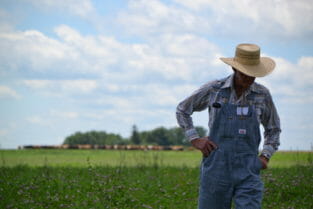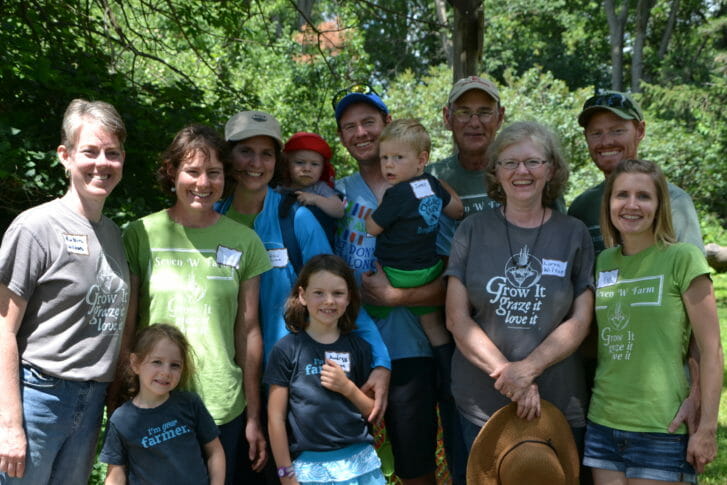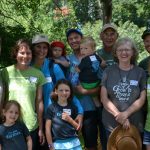Field Day Recap: Improving Organic Crop Production
“What’s your favorite summer activity?”

Nora, Jaron, Dan, Lorna, and Torray Wilson listen as others share their favorite thing about summer
Attendees at Wilson’s field day July 20 near Paullina kicked off the day by introducing themselves and answering this question. Member Pedro Esquivas got kudos for traveling the farthest, from Madrid, Spain! Long-time member Paul Mugge who farms near Sutherland had the funniest answer: walking beans.
Dan and Lorna introduced the field day and provided farm history. The event was a family affair; all the Wilsons were in attendance minus daughter Faye and her husband Matthew, who were at a youth camp in Eastern Iowa. Dan and Lorna talked about the evolution of the farm and family: Dan’s parents, Beth and her late husband Ernie raised their family at the home site, where the field day was held. Dan did the same with his family. Now Beth lives nearby in Paullina; Dan and Lorna live within walking distance down the road; son Torray and wife Erin live at the home site; daughter April will soon live in a new home down the road; and Jaron and wife Liz, Faye and husband Matthew, and Robin live in Paullina.
As adults kids have returned to the farm, they have brought their own skillsets. Torray and Erin oversee the dairy operation; April cares for pigs and other livestock; and Jaron brings skills to better use technology and equipment.
The Wilsons held the field day to showcase techniques to improve organic crop production. Dan said, “What we want everybody to know is that we don’t have all the answers, as you will see. In true PFI fashion, hopefully we’ll all learn something today.”
Rotations
The Wilsons 660-acre farm is broken into 29 fields. They have three different rotations:
- Near the dairy, the land is in pasture for 5-7 years, and then row crops for 2-3 years
- Hay, corn, soybeans, oats underseeded with hay—this has been a 4-year rotation but is transitioning to a 6-year rotation, as the Wilsons have decided to leave the hay for two years
- Corn, soybean, corn, oats underseeded with Albert Lea-Organic plowdown
Planting
Torray and Jaron led attendees through their planting and weed control processes. Weed control can be the biggest barrier to successful organic production. Torray said, “Timing is key.”
To prepare the seedbed, the Wilsons do an early light disc with a Kraus disc. They then use a Deutz-Allis 1400 for early spring tillage. Jaron and Torray prefer the 1400 to the 1200 model.
Torray and wife Erin have gotten some training and Holistic Management. Part of that training includes analyzing your system for weak links. Each winter the Wilsons identify one improvement to make. Torray explained: “Last year our weakest link was our planter.” After attending a planter class at PFI’s annual conference, the Wilsons learned they should check their planter each year—check tubes and discs to make sure they are in working order. The Wilsons invested in a new-to-them John Deere 7200 planter and purchased new seed tubes and discs for the planter. They recommended eSets or a Promax 40 planting disc from John Deere.
Tech-savvy Jaron purchased a custom-made planting monitor from outfarming.com, located in Ankeny. Jaron said, “We went into the middle of suburbia to buy a planter monitor.”
The Wilsons also received an old RTK GPS system from Paul Mugge. Jaron warned, “It’s like farmer’s cocaine.” Now that he has used it, he doesn’t want to plant without the precision the GPS provides.
Recently Torray and Jaron had a learning experiment with calibrating seed drills for cover crops. They read in a PFI publication that it is important to calibrate your drill for accuracy. Torray’s mindset is to get things done, so he forego calibration, and ran out of seed. Jaron, the more precise brother, calibrated according to instructions in PFI publication, and had seed leftover.
Here is a video on calibrating, as well as a Wallace’s Farmer article.
Weed control
After seeds are planted, the Wilsons try to make 3, sometimes 4, passes with a rotary hoe before using a cultivator:
1) First pass blind before germination, 3 days after planting. This is when, if you scratch the surface, you will see white ‘weed hairs’ starting to germinate.
2) Second pass 3 to 4 days later, when cash crop is in cotyledon stage. It has germinated but not yet grown true leaves.
3) Third pass 3 to 4 days later, right before cultivation.
They like to go about 12 miles per hour with the Rotary Hoe , a pretty quick speed to, as Torray said, “Get it done.”
Their Yetter rotary hoe is aptly called the Red/Green, since its original red components are slowly being replaced with green. Dan explained that they have switched to John Deere bearings because they seem to work the best. He added, “You need good bearings and good, wide tips on the spoons. If you can’t feel the rib on a spoon, it is time to replace it.”
If you need tips about rotary hoes, Jaron said, “Talk to Doug Alert,” a PFI member who farms near Hampton. In addition, Vic Madsen, who farms near Audubon, said, “Bob at Rock Valley can build you any kind of rotary hoe you want.”
After using the rotary hoe, each time the weeds get to 1-2 inches tall, Torray said, “It is time to cultivate.” The Wilsons use a Buffalo Cultivator for their first cultivator pass, and make the pass at 2.8-3.5 miles per hour. Scott Shriver, who farms near Jefferson, provided the Wilsons a tip to improve the cultivation by adding an extra cutaway disc.
The Wilsons use a Weatherell Cultivator, for the second pass, at 4.5-5.5 miles per hour. They have added flow shields to put the soil back into the bean row. They have also added wheel weights. Sometimes the Wilsons will make a third cultivation pass, but this is not common.
Sometimes cultivation fails and weeds prevail. The Wilsons offered three options:
1) Hire bean walkers if the weeds aren’t terrible.
2) Graze the crop or chop for sileage.
3) Clean weed seed from the crop with a seed cleaner before storing the crop.
Paul Mugge shared his experience this year controlling weeds with a flame weeder. He said, “They work well if you know how to use them correctly.” Paul flamed beans at cotyledon stage and it worked splendidly. He also flamed again at v5, when the beans were about 12-16 inches tall. “The jury is still out on how this will work,” said Paul. It did an effective job cleaning up weeds, but his beans show burn damage on the bottom 5 inches. At harvest he will be able to determine if this caused a yield dip.
Experimentation and innovation
Torray is experimenting with 111-day corn silage interseeded with 110-115 day sorghum for cattle feed in a field adjacent to their dairy building. They drilled the sorghum, and then seeded corn. In hindsight, Torray thinks he should have seeded the corn first. In addition, sorghum germination was poor due to planting too deep.
After a delicious homegrown lunch, the 50-plus field day attendees boarded hayracks to travel to fields east of the home site, and showcased some trials and innovative plantings.
The Wilsons explained that many organic growers are not using organic seeds because organic hybrids aren’t reputed to yield as strongly as their conventional counterparts. To inspect this further, the Wilsons are conducting side-by-side trials of Beck versus Great Harvest seeds. Great Harvest is a sister company of Beck, that provides organic seeds using the same genetics as their conventional counterpart. The Wilsons are testing 105-day Great Harvest 55E4 organic versus Great Harvest 5140 non-gmo. They are also testing 97-day Great Harvest 47N2 versus Great Harvest 4721 non-gmo.
The Wilsons drove people by their organic soybean fields. Prior to soybeans, cereal rye had been grazed until May. Torray explained, “Weeds in the field tell you where you messed up.” Jaron, thinks that wet conditions and speed of cultivating didn’t effectively kill grasses in certain areas of the field.
Torray said, “We try to be students of nature and follow what it is doing.” Where weeds come up in the system, they try to fill in future years with cover crops like radish, so something they want, versus weeds, grows.”
Attendees viewed the Wilson’s mix of alfalfa and Diverse Master from Prairie Creek seed. This diverse mix had been windrowed the day before, and will become feed and bedding.
Enterprise diversity

Jim Mathis with dairy herd in background
Along the tour, Dan said, “Dairy has been a key addition to our system.” The Wilson use dairy manure and bedding for fertilization and they can feed forages to the dairy herd. Torray and Erin dry out their herd in July, and take a welcome farmer holiday!
The Wilsons also pointed out their chicken house—layers follow the dairy herd in the pasture, breaking up cow pies and fly cycles. The Wilsons have also installed tree swallow houses across the pasture for added fly control.
Near the end of the tour, Torray explained how they have moved their sheep herd to Robert Alexander’s 11 miles down the road. They had too many enterprises on the Wilson farm, and the balance is better now with the sheep elsewhere. Torray talked about the benefits both spiritually and business-wise of having a multitude of enterprises as seen at the Wilsons. He said, “Adding another enterprise is like adding a color to your masterpiece. But we don’t start out as toddlers being able to paint Monet, it takes practice to effectively diversify.”
Torray ended the tour talking about the spiritual energy farming provides. While farming is physically enduring and stressful, at moments it is peaceful. Torray said, “My favorite thing about farming is standing still and quiet in the field, feeling the breeze, listening to the birds, and watching things grow around me.”
Thanks to the Wilsons for another successfully field day generously sharing information farmer-to-farmer!

The Wilsons, from left to right
Front: Nora and Audrey
Back: Robin, April, Erin, Lewis, Torray, James, Dan, Lorna, Jaron and Liz
Not pictured: Beth, Walter, Faye and Matthew

